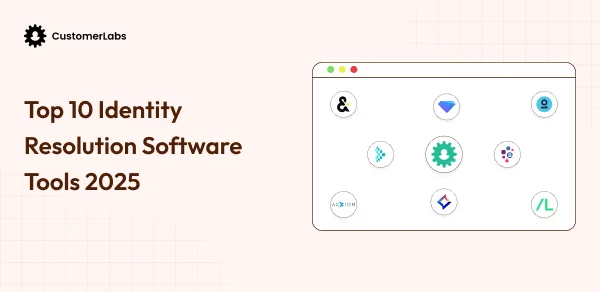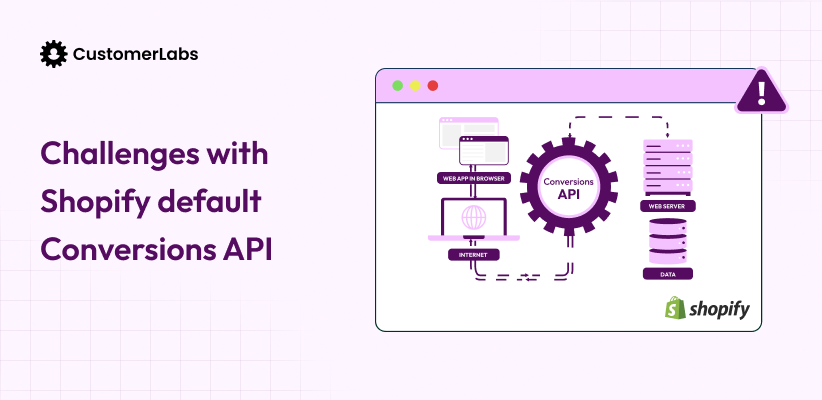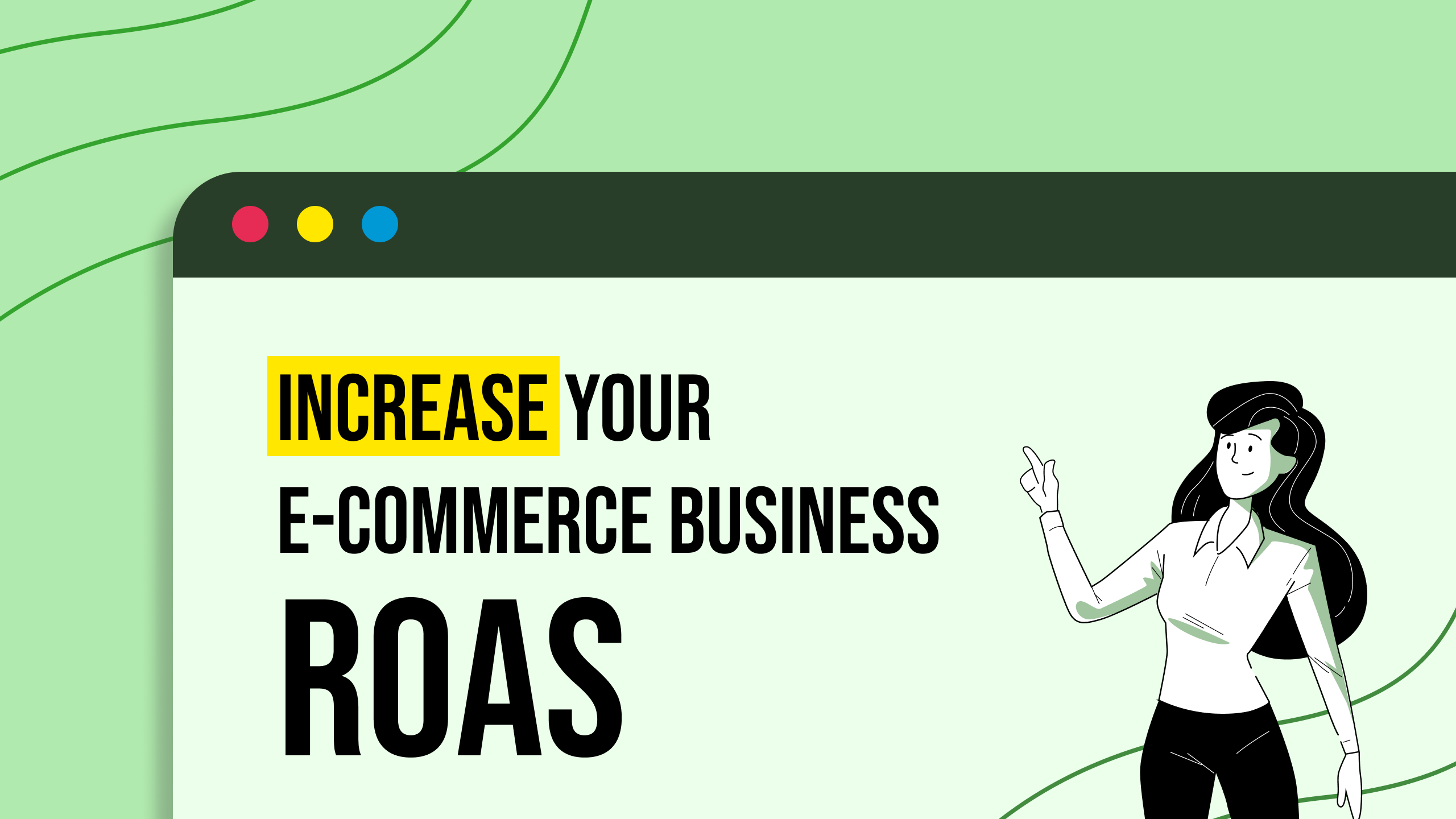I’m gonna start with something, that will make you question, Is that for real?
Did you know that, 98% of website visitors leave without converting? Yes, it is true. But do you know why?
Because they are unknown or anonymous website visitors.
Imagine — while setting up retargeting campaigns, you only target the known leads, the ones who have revealed their identity by making a purchase. And that’s only 2% of the entire website visitors.
So how do you tackle this problem?
By activating the anonymous website visitors, the 98% users. Want to know how, then stay till the end.
In this blog, you will get to know why these anonymous website visitors matter and how to activate them effectively for the benefit of your businesses.
Drum roll… Let’s begin by asking Who
Who Exactly Are “Anonymous” Website Visitors?
Anonymous visitors are the users who land on your site but leave without a trace—no login, no form fills, no transactions.
Let me give you a small scenario to imagine,
These anonymous visitors enter your website, browse through your product pages, read your blogs, add products to cart but don’t check out or even maybe possess traits of a window-shopper (I do that most of the time).
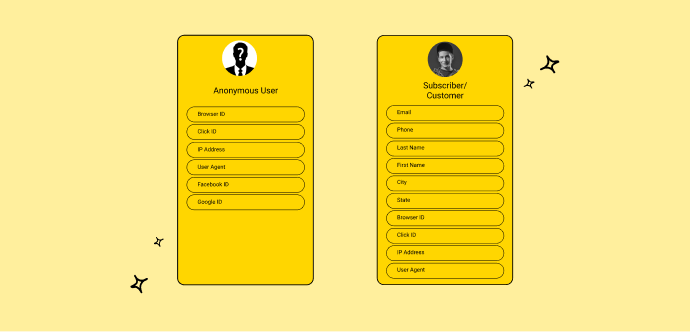
But because they remain unidentified, traditional marketing systems ignore them. They’re real, they’re active, and they’re high intent—but invisible in your CRM or to your ad platforms.
If you probably think, why I should activate these anonymous visitors, then the next section is for you.
Why Should You Activate Anonymous Website Visitors?
Because you already paid to acquire them. Possibly through your long-term SEO efforts, writing a blog or running an ad, you have made efforts, and it brought them halfway through.
Let’s say you run a DTC brand that sells premium running shoes online. This month, you spent $10,000 on Meta and Google Ads to drive traffic to your site. Great creatives, strong click-throughs—you got 10,000 visitors.
Here’s what actually happens:
Only 200 visitors convert (they buy or fill out a lead form).
That means 9,800 people left without taking action.
So now you’re looking at a $50 cost per conversion, and nearly $9,800 in ad spend goes untouched.
Here’s the kicker:
Of those 9,800 visitors, a few hundred:
- Spent 3+ minutes on your product pages
- Viewed your “Best Sellers”
- Added items to cart
- Revisited the site from different devices
But since they didn’t identify themselves—no login, no form fill, no email. no pixel. no CRM entry. Just missed opportunity.
And you can’t retarget them the traditional way. They remain anonymous in your system.
The above-mentioned behaviors are high intent but underutilized. So by activating these anonymous visitors, you can:
- Get better CTR on retargeting campaigns, since you are targeting the audience who has the intent towards purchasing.
- Lower your CPA since you’re no longer wasting budget on cold audiences. You’re targeting warm users who’ve already shown intent—just anonymously. That results in fewer impressions, more clicks, and cheaper conversions.
- Improve your ROAS dramatically, instead of driving more cold traffic, you’re converting already-interested visitors. ROAS goes from 3x to 6x.
- Optimize your entire funnel—not just the last touchpoint. With traditional way of retargeting, you will only focus targeting only the BOFU users. But when you activate the anonymous visitors, you also can retarget the juicy MOFU, thereby optimizing your ads for full funnel.
Now that you know what you were missing out without activating your anonymous website visitors, let’s understand how to activate them.

Also read on the importance of anonymous website visitors
How to Activate Anonymous Website Visitors in Meta Ads
Let me put it straight there is no step-by-step process for activating the anonymous website visitors, rather you will have to think from a strategical viewpoint.
First things first,
Everything starts with the quality data that you collect
You need to start by tracking, collecting and storing quality first-party data of the anonymous users who visit your website. Every anonymous visitor (but not just limited to) has a stream of behavioral signals: clicks, scrolls, page visits, engagement time on site.
Connect the dots
Once you have the anonymous visitors 1PD ready, now begin with connecting the touchpoints of users (picture a spider web) to bring out a unified customer profile. For instance, User A clicked an ad, then reached your website, viewed a specific product, again clicked on an ad… so on and so forth.
You have to follow do this for every individual anonymous user without missing out on any key touchpoints. And, if you have any offline touchpoints like an in-store visit, try to incorporate them as well.
When you unify the entire user journey, you will be able to understand different specific trails of the users. Basically, you will be able to identify behavioral patterns.
Split them up
By now, you will have the 1P data and would have identified users with similar patterns. Now start segmenting them like groups. For instance, segment the users who have shown interest towards a specific product category or a specific product, or users who made repeated visits, say like more than 3 times.
Segment users by their behavioral patterns that you identified based on your business goals. Think like this, let’s take this segment, the users who have shown interest towards a specific product category or a specific product. You should strategically think whether will you be able to retarget these users with behavioral pattern.
No theory, just pure strategy.
Send it back
Keep the segmented users ready and send them back to the ad platforms (stay to find out how). Setup Meta Conversions API aka Facebook CAPI via server-side and send these user data back to Meta for targeting without any blockers.
Setup Campaigns
Launch personalized retargeting campaigns and hit run. Meta can now serve hyper-personalized ads to these segmented, anonymous visitors—right in their feed, based on actual behavior, not assumptions.
Seal the loop
When the user finally converts (fills a form or makes a purchase), map the conversion to their behavior history. This way, you turn unknown users into full-funnel known customers—with all their behavioral data intact.
So there you have it. This is how you can activate anonymous website visitors into known users and thereby increasing the overall revenue.
If you are read between the lines, you can find challenges that might pose as a hindrance to set this process. Let’s look into the possible challenges that you might be facing while activating the anonymous users.

Challenges in Activating Anonymous Website Visitors
Cross-Device and Cross-Session Tracking:
These days, users are super unpredictable. A single user may click a Meta ad on their iPhone during lunch and revisit your website on a desktop later that night, then browse your product again on a tablet the next day.
If you don’t properly capture these signals to you, it might look like three different anonymous visitors. Most of the tracking system now rely on cookies, which don’t persist across browsers or devices. That means you’re losing continuity in your user journey, which weakens your retargeting effectiveness.
Inability to unify browser ID and user agent:
To activate, you have to stitch the touchpoints together to understand their behavioral patterns. When a user is anonymous, all the identifiers you’ve got are like browser ID, IP address, or user agent. On their own, these signals are weak. And privacy constraints limit how much detail you can pull.
You need a system that can safely and intelligently correlate signals across sessions and devices without violating user consent.
Difficulty in segmenting the audiences:
Raw behavioral data is messy. You need to translate it into segments that align with your business goals. Without proper automated systems in place, going through every user profile and segmenting them according to the high intent vs. low intent, top-funnel vs. bottom-funnel, etc. is more like a never ending and tiring process.
Meta’s 28-day event cycle:
Let’s say that you somehow managed to get the data in order after pulling the man-hours and a lot of strain. There is another catch, which will still make all your efforts go in vain. Meta will only hold onto the custom events that you send not more than 28 days.
This means, if you delay syncing data or launching retargeting campaigns, that audience may already be gone. Your retargeting pipeline must be real-time or near real-time, not delayed by manual exports or third-party syncs.
Technical complexity of CAPI setup:
Meta’s CAPI is the gateway to high-performance remarketing—that’s the literal gateway through which you send the events back. Here, the challenge is integrating a proper server side CAPI setup, which isn’t easy.
Unless you’ve got in-house devs with adtech experience, this setup can take weeks—and if you mess it up, your ad attribution will be off, or worse, your events won’t fire at all.
Privacy Isn’t Optional Anymore:
Privacy has become of prime concern of the users and it has become a necessity to follow the privacy laws and strict regulations putforth by the ad platforms. Collecting your own first-party data doesn’t mean you’re off the hook.
Rather it just means you should act responsible on how it’s collected and used. Without a compliant framework, your 1PD strategy can backfire for you and you might end up losing the trust your users have on you.
Lack of internal bandwidth or tooling:
Let me be honest with you, you might be a marketer but you cannot pull this off alone. Most performance marketers are stretched thin and in order execute this strategically you need the more technical knowledge into developing, coding and integrating.
But not just that, setting up multiple systems is huge. You can’t just install a pixel and expect anonymous visitor retargeting to work. You need behavio tracking system, identity stitching capabilities, consent management platforms, systems to sync the data real-time with Meta, a separate system for segmenting the users.
You can still overcome all these challenges with the right technology.
Best Technology to Overcome Challenges and Effectively Activate Anonymous Website Visitors
So far, you understood why—the 98% of visitors you’re leaving behind are often your most valuable leads, and traditional tools simply weren’t built to capture and convert them.
That’s why you need the right system in place.
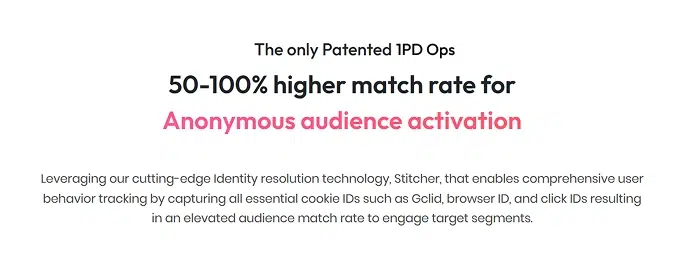
And it is a 1PD Ops platform like CustomerLabs – it’s a marketer-friendly 1PD engine built to turn anonymous visitors into high-ROAS Meta audiences.
Here’s is a clear justification on why and how?
One-Click Integration
With one-click integration, CustomerLabs captures all user actions both known and anonymous—from product views to scroll depth to add-to-cart—and automatically pairs it with consent status.
Identity Resolution
The identity resolution feature of the 1PD Ops platform helps connect the dots and unify multiple touchpoints from various destinations, you name it. This means even without PII, you get a persistent user profile enriched over time—and once that person converts or logs in, all historic behavior is automatically mapped to their identity.
Audience Segmentation
Using CustomerLabs 1PD Ops’ visual interface (no SQL, no code), you can build dynamic audience cohorts based on behavioral depth, frequency, intent and funnel stage. These aren’t just static audiences — they update in real time as users move across your funnel. CustomerLabs even lets you define micro-conversions as custom events through which you can provide the algorithm with stronger signals to optimize ad delivery.
Easy no code integrations
CustomerLabs is specifically designed for performance marketers like you. You really don’t need to know coding or even need a developer’s help to integrate CAPI, setup server-side tracking or even to integrate with multiple sources like your CRM and destinations like Meta or Google. It’s all pre-built. You just toggle on/off and complete the setup or push the data to Meta in real time.
1P Domain tracking
With CustomerLabs you can do 1P Domain tracking. With first-party (1P) domain tracking, it sets durable, consent-based cookies directly on your domain. This ensures extended cookie lifespans, reliable user ID stitching, and provides you with full control over how tracking works, without browser limitations. This is how you can sustain accurate attribution in a post-cookie world.
Also read on Cookieless Tracking: Strategies and Tools for Marketers
CustomerLabs 1PD Ops isn’t just a toolkit. It’s an entire infrastructure—designed for performance marketers who want to scale without hand-holding developers every step of the way.
Now you know the easy and effective way to activate the anonymous website visitors. Let’s look into some benefits of it.
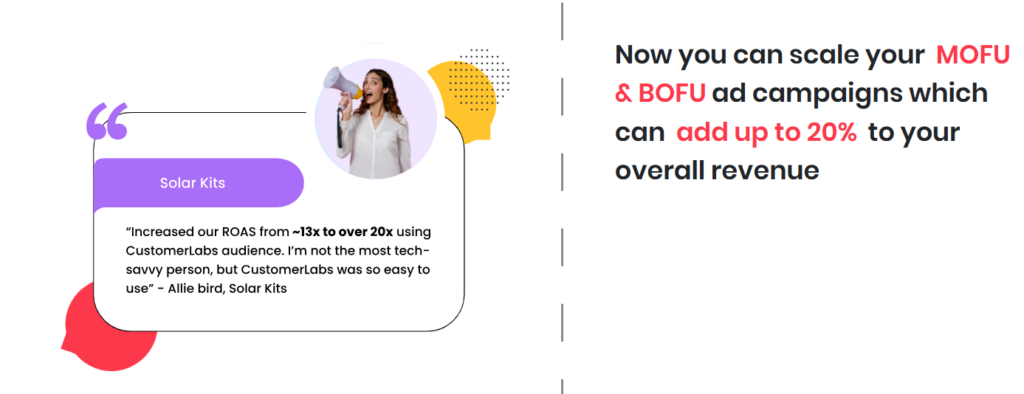
Benefits of Activating Anonymous Website Visitors
- By activating anonymous website visitors, you can convert 50% of the unknown visitors into known users with behavioral retargeting. And you will not lose out on the 98% of visitors and end up strategically converting them.
- Instead of setup campaigns for blind targeting, through anonymous website activation, you can setup campaigns with quality signals. Since you ask Meta to target more relevant, timely, and high-intent audiences, the better will be the performance, thereby increases your ROAS on Meta ads.
- Customer acquisition costs (CAC) are at an all-time high. But activating the warmest leads who are already visiting your site, you will spend less on reaching new audiences and improve funnel efficiency by focusing on users already familiar with your brand. By doing so you can see a significant CAC drop over time, especially when paired with high-quality creative and offers.
- As the anonymous audience activation improves the retargeting precision, it will naturally shorten the buyer journey and increase the conversion rates. Ultimately, this will lower your cost per purchase (CPP) across campaigns — especially for high-ticket or subscription products.
- When you activate anonymous users, you’re not just improving ads — you’re improving your understanding about the entire customer journey. You gain insight into what paths users take before converting, where high-intent users drop off and which segments engage with which content, and many more like these. This visibility helps you improve messaging, landing pages, and offers — your overall marketing efforts and strategy, not just ads.
If I could list all the benefits, then it will be a separate long list. You can reap n number of benefits by activating your anonymous website visitor.
It’s Time to Stop Losing the 98%
If you’ve made it this far, one thing should be clear—anonymous website visitors are not lost causes. They’re untapped goldmines sitting silently in your analytics.
They’ve shown interest. They’ve browsed, clicked, and maybe even added items to their cart. Since you don’t have the right system in place, they are a lost cause at the moment.
That’s exactly where a 1PD Ops platform like CustomerLabs changes the game. It bridges the technical gap, automates the hard stuff, and empowers marketers to own their data and run better-performing campaigns—without needing a dev team on speed dial.
So if you’re ready to take back control of your funnel, retarget smarter, and finally capture the 98%—then it’s time to rethink how you treat your anonymous visitors.
Ready to stop losing the 98% of your website visitors? Book a Demo now and turn them into revenue.

